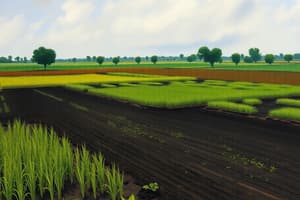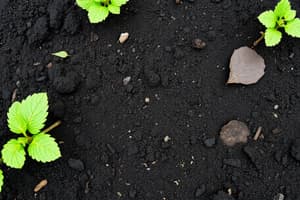Podcast
Questions and Answers
How does the high water retention capacity of black soil influence the types of crops that can be successfully cultivated in it?
How does the high water retention capacity of black soil influence the types of crops that can be successfully cultivated in it?
The high water retention capacity makes black soil ideal for crops that require a lot of moisture, such as cotton, by sustaining them through dry periods.
Explain how the climatic conditions under which laterite soil is formed affect its fertility and suitability for agriculture.
Explain how the climatic conditions under which laterite soil is formed affect its fertility and suitability for agriculture.
The alternating wet and dry conditions lead to leaching of minerals, reducing fertility. This means fertilizers are needed to grow crops like cashew, tea, and coffee.
What are the primary limitations of desert soil for agricultural use, and how can irrigation help overcome these challenges?
What are the primary limitations of desert soil for agricultural use, and how can irrigation help overcome these challenges?
The primary limitations are its sandy texture, infertility, high salt content, and low moisture. Irrigation helps by providing the necessary water for crops like millet and jowar to grow.
Given its location in mountainous regions, what challenges does mountain soil present for agricultural practices, and how do farmers adapt to these conditions?
Given its location in mountainous regions, what challenges does mountain soil present for agricultural practices, and how do farmers adapt to these conditions?
Describe the relationship between the decaying leaves (humus) found in forest soil and its suitability for cultivating crops like wheat, maize, and barley.
Describe the relationship between the decaying leaves (humus) found in forest soil and its suitability for cultivating crops like wheat, maize, and barley.
How might the physical characteristics of black soil, such as its stickiness when wet and development of fissures when dry, affect agricultural practices and soil management?
How might the physical characteristics of black soil, such as its stickiness when wet and development of fissures when dry, affect agricultural practices and soil management?
Considering that laterite soil is less fertile, what specific nutrients might be lacking, and how do fertilizers replenish these to support crop growth?
Considering that laterite soil is less fertile, what specific nutrients might be lacking, and how do fertilizers replenish these to support crop growth?
How do the high temperatures and evaporation rates that influence the development of desert soil contribute to its infertile condition, and what role do organic matter and moisture play in improving it?
How do the high temperatures and evaporation rates that influence the development of desert soil contribute to its infertile condition, and what role do organic matter and moisture play in improving it?
Flashcards
Black Soil
Black Soil
Also known as Regur soil, covers ~15% of India, formed from Deccan lava.
Black Soil Characteristics
Black Soil Characteristics
Rich in potash, aluminum, and magnesium carbonates; high water retention.
Crops grown in Black Soil
Crops grown in Black Soil
Cotton, linseed, mustard, groundnut, tobacco
Laterite Soil
Laterite Soil
Signup and view all the flashcards
Laterite Soil Characteristics
Laterite Soil Characteristics
Signup and view all the flashcards
Crops grown in Laterite Soil
Crops grown in Laterite Soil
Signup and view all the flashcards
Desert Soil
Desert Soil
Signup and view all the flashcards
Mountain Soil
Mountain Soil
Signup and view all the flashcards
Study Notes
Black Soil
- Black soil, also known as Regur soil, covers approximately 15% of India's total area.
- It formed from the spreading of Deccan lava.
- Black soil is found in Maharashtra, Western Madhya Pradesh, Andhra Pradesh, parts of Karnataka, and the Gujarat districts of Surat, Bharuch, Narmada, Vadodara, Tapi, and Dang.
- Lava rocks and climate play an important role in the formation.
- Proportionally high in iron, lime, calcium, potash, aluminum, and magnesium carbonates.
- Known for being quite fertile and has a high moisture retention capacity.
- When moisture evaporates, fissures develop.
- Suitable crops include cotton, linseed, mustard, groundnut, tobacco, and udad.
- Referred to as Black Cotton soil due to its suitability for cotton cultivation.
Laterite Soil
- The term "Laterite" comes from the Latin word "Later," meaning brick.
- Red color comes from iron oxide.
- When wet, it has a smooth, buttery texture and becomes very hard when dry.
- Formed due to the change of dry and moist climate.
- Developed in the higher peninsular plateau of India.
- Contains more iron, potash, and aluminum.
- Less fertile, but cotton, paddy, ragi, sugarcane, tea, coffee, and cashew can be grown with fertilizers.
Desert Soil
- Found in arid and semi-arid regions.
- Sandy and infertile soil type.
- Contains more dissolved minerals.
- Found in Rajasthan, Haryana, Southern Punjab and Kachchh and other parts of Saurashtra in Gujarat.
- Crops like millet and jowar can be cultivated with irrigation.
Mountain Soil
- Found in the valley and sloppy regions of the Himalayas.
- Found at altitudes between 2700 to 3000 meters.
- Typically has a thin and underdeveloped layer.
- It is found in Assam, Darjeeling, Uttarakhand, Himachal Pradesh and Kashmir.
- Commonly found with pine and chid trees.
Forest Soil
- Found within the altitude between 3000 and 3100 metres
- Exists in the coniferous forests of the Himalayas, Sahyadri, Eastern Ghats, and the Terai region of the Himalayas.
- Earth's surface covered by shaded leaves turns the topsoil black due to decaying leaves increasing the humus content.
- The soil may turn blue or red as you go deeper into the soil.
- In limited areas tea, coffee, spices and crops like wheat, maize, and barley etc are cultivated
Studying That Suits You
Use AI to generate personalized quizzes and flashcards to suit your learning preferences.




